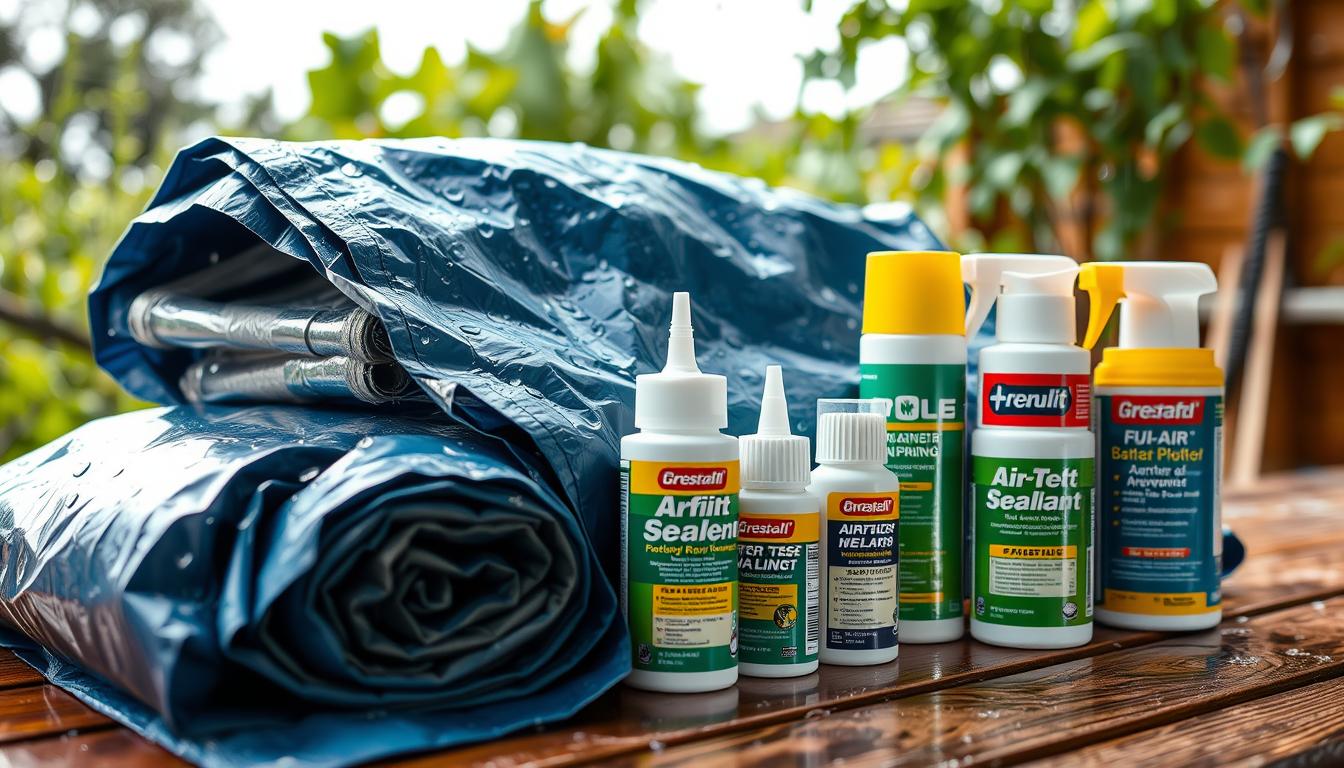Weatherproofing is vital for the long-term success of outdoor projects. It shields materials from the destructive effects of heavy rain, intense sunlight, and extreme temperatures. By using effective weatherproofing techniques, you can ensure your outdoor creations remain intact and durable.
Implementing robust material protection and weatherproofing can significantly extend the life of your outdoor projects. This approach minimizes the need for expensive repairs and replacements. By grasping the significance of weatherproofing and material protection, you can actively safeguard your outdoor investments.
Key Takeaways
- Weatherproofing is essential for outdoor project protection
- Material protection helps prevent damage from harsh weather conditions
- Effective weatherproofing measures can ensure the longevity of outdoor projects
- Material protection can help reduce the need for costly repairs and replacements
- Understanding weatherproofing and material protection is crucial for protecting outdoor investments
Understanding Weather Threats to Outdoor Projects
Outdoor projects face numerous weather challenges that can impact their outdoor durability and weather resistance. It’s crucial to grasp the dangers posed by weather to ensure these projects last. UV radiation, moisture, and temperature changes are the main culprits behind damage.
These elements can cause discoloration, warping, and cracking. UV radiation can degrade materials, while moisture leads to rot and mold. Temperature changes cause materials to expand and contract, leading to structural issues.
Impact of UV Radiation
UV radiation poses a significant threat to outdoor projects, affecting materials like plastic, wood, and metal. Prolonged UV exposure can make these materials brittle, crack, or discolor. To counteract this, using materials with UV protection or applying a UV-resistant coating is essential.
Effects of Moisture and Rain
Moisture and rain can severely damage outdoor projects. Water can seep into cracks, harming the structure and foundation. Moisture also fosters mold and mildew growth, weakening the project’s integrity.
Temperature Fluctuation Challenges
Temperature changes are another challenge for outdoor projects. Extreme temperatures can cause materials to expand and contract, leading to damage. For instance, metal becomes brittle in cold, while plastic softens in heat.
To enhance the weather resistance of outdoor projects, consider these factors during design and construction. Choosing materials with high outdoor durability and applying protective coatings can help withstand weather effects. This ensures your project’s longevity.
| Weather Factor | Effect on Outdoor Projects | Mitigation Strategy |
|---|---|---|
| UV Radiation | Discoloration, degradation | Use UV-resistant materials or coatings |
| Moisture and Rain | Water damage, mold, and mildew | Use waterproof materials, apply sealants |
| Temperature Fluctuations | Structural damage, material degradation | Use materials with high temperature resistance, apply protective coatings |
Essential Weather Protection Materials
Protecting outdoor projects from weather damage requires the right materials. Protective measures are key here. By selecting the correct materials, you can greatly lower the risk of weather damage. This ensures your outdoor creations last longer.
Effective weather protection materials include sealants, coatings, and membranes. These are vital for safeguarding various outdoor projects. From decks and patios to roofs and walls, these materials create a barrier against rain, sunlight, and extreme temperatures.
Using weather protection materials offers several benefits:
- Reduced risk of water damage
- Protection against UV radiation
- Increased durability and longevity
Implementing the right protective measures keeps your outdoor project safe in harsh weather. Always choose materials fitting your project and follow the manufacturer’s application and maintenance guidelines.
Selecting the Right Protective Coatings
Choosing the right protective coatings for outdoor projects is vital to withstand weather damage. With numerous options, selecting the ideal one can be daunting. Consider the material type, weather conditions, and the level of protection needed to simplify your decision.
Water-Resistant Sealants
Water-resistant sealants are a top choice for outdoor protection, offering a moisture barrier. Popular types include silicone and polyurethane-based sealants. Always adhere to the manufacturer’s guidelines and use maintenance tips to maintain the sealant’s effectiveness.
UV-Protective Finishes
UV-protective finishes shield outdoor projects from ultraviolet light damage. They work on various materials like wood, metal, and plastic. To maximize your UV-protective finish, follow the manufacturer’s maintenance tips and apply it as instructed.
| Protective Coating | Benefits | Application Tips |
|---|---|---|
| Water-Resistant Sealants | Moisture protection, durability | Follow manufacturer’s instructions, apply in well-ventilated area |
| UV-Protective Finishes | UV protection, color retention | Apply according to manufacturer’s instructions, use in well-ventilated area |
Seasonal Weather Protection Strategies
As seasons shift, it’s vital to adjust your outdoor project protection plan to meet climate considerations. Each season poses unique weather challenges. Being ready is key to your project’s long life.
Seasonal weather protection involves several aspects. These include winterizing, protecting against summer heat, and maintaining in spring and fall. Knowing each season’s specific challenges helps craft a detailed protection strategy. This addresses climate considerations effectively.
Some essential strategies for seasonal weather protection include:
- Winterization: Protecting your project from freezing temperatures and moisture
- Summer protection: Shielding your project from intense sunlight and heat
- Spring and fall maintenance: Preparing your project for changing weather conditions and addressing any damage that may have occurred during the previous season
By being proactive in seasonal weather protection and considering climate considerations, you can ensure your outdoor project’s long-term success and durability.
Advanced Weather Protection Techniques
Advanced techniques offer an extra layer of security against weather damage for outdoor projects. Weatherproofing and material protection are key to ensuring your project’s longevity. Professional methods and industrial-grade solutions safeguard your investment against the elements.
Specialized coatings and sealants are among the advanced weather protection techniques. These can be applied to materials like wood, metal, and concrete. They create a barrier against moisture and UV radiation. Material protection is vital for maintaining your project’s integrity, and these methods help achieve that.
Modern protection technologies, such as waterproof membranes and drainage systems, can also be integrated into your project. These solutions prevent water damage and reduce structural risks. By using these advanced techniques, your outdoor project remains protected and looks great.
Key considerations for advanced weather protection include:
- Assessing the project’s exposure to weather elements
- Selecting the right materials and coatings for the job
- Implementing a regular maintenance schedule
By proactively addressing weatherproofing and material protection, your outdoor project can last for years.
Design Considerations for Weather Resistance
When designing an outdoor project, it’s crucial to consider the factors that affect its outdoor durability and weather resistance. A well-designed project can withstand various weather conditions. This ensures its longevity and minimizes maintenance costs.
To achieve this, it’s essential to focus on structural elements, such as the foundation, walls, and roof. These elements provide the framework for the project. The selection of materials also plays a vital role in determining the project’s weather resistance.
Structural Elements
A strong foundation is vital for withstanding weather-related challenges. The type of material used for the foundation, walls, and roof can significantly impact the project’s outdoor durability.
Material Selection Guidelines
Choosing materials that can resist weather damage is critical. Consider their ability to withstand UV radiation, moisture, and temperature fluctuations when selecting materials.
Drainage Planning
Proper drainage planning is also essential to prevent water accumulation. Water accumulation can lead to damage and reduce the project’s weather resistance. A well-designed drainage system can help maintain the project’s outdoor durability and extend its lifespan.
By considering these design elements and incorporating weather-resistant materials, you can create an outdoor project that can withstand various weather conditions. This ensures its longevity and minimizes maintenance costs.
Monitoring and Maintenance Protocols
Regular monitoring and maintenance are vital for protecting outdoor projects from weather damage. By adopting protective measures, individuals can avoid expensive repairs and prolong their projects’ lifespan.
Creating an effective maintenance plan requires understanding the specific needs of your outdoor project. This involves regular inspections, repair methods, and strategies for replacing worn-out parts. Key considerations include:
- Inspecting the project regularly for signs of weather damage
- Implementing repair techniques, such as sealing cracks and replacing damaged materials
- Developing a replacement strategy for worn-out or damaged components
By following these steps and implementing protective measures, individuals can keep their outdoor projects safe and secure, even in harsh weather.
Remember, regular monitoring and maintenance are crucial for preventing weather-related damage and extending the lifespan of outdoor projects.
| Maintenance Task | Frequency | Importance |
|---|---|---|
| Inspecting the project | Regularly | High |
| Implementing repair techniques | As needed | Medium |
| Developing a replacement strategy | Annually | Low |
Emergency Weather Protection Measures
When severe weather is forecasted, immediate action is crucial to safeguard your outdoor project. Adhering to maintenance tips is vital to ensure your project can endure extreme weather. Preparation is essential to reduce damage and extend your project’s lifespan.
A solid emergency plan should include storm preparation tips. This includes securing loose items, covering sensitive equipment, and strengthening weak structures. Also, having a plan for temporary protection solutions can help prevent damage from unexpected weather.
After a storm, conducting a detailed post-storm assessment is critical. This involves checking for structural damage, inspecting protective coatings, and evaluating your emergency measures’ effectiveness.
Storm Preparation Tips
- Secure outdoor furniture and decorations
- Cover sensitive equipment and electronics
- Reinforce weak structures and roofs
By following these maintenance tips and having a well-thought-out emergency plan, you can safeguard your outdoor project against severe weather. This ensures its longevity.
Cost-Effective Weather Protection Solutions
Protecting outdoor projects from weather damage is crucial, and climate considerations are key. With tight budgets, finding affordable yet effective solutions is vital. DIY methods like waterproof sealants and UV-protective finishes are great options.
Choosing budget-friendly materials is another smart move. Opting for recycled or sustainable products can cut costs and help the environment. Also, energy-efficient strategies can lower energy bills and expenses.
Some effective, yet affordable, weather protection methods include:
- Using waterproof coatings to protect surfaces from moisture
- Applying UV-protective finishes to prevent damage from sunlight
- Implementing drainage systems to prevent water accumulation
By considering climate considerations and using these cost-effective methods, you can safeguard your outdoor projects. It’s important to evaluate each option’s cost and benefits to find the best fit for your project.
Environmental Considerations in Weather Protection
Weatherproofing must consider the environmental impact of our actions. Protecting outdoor projects from the elements requires thinking about the environment’s effects. We should focus on eco-friendly materials and sustainable practices.
Material protection is key in weatherproofing. Choosing the right materials significantly impacts our projects. Eco-friendly options like recycled plastics, sustainably sourced wood, and low-VOC paints reduce our carbon footprint. They contribute to a sustainable future.
Implementing sustainable practices is also crucial. This includes reducing waste, using energy-efficient methods, and avoiding harmful chemicals. A holistic approach to weatherproofing protects our projects and the environment.
- Using materials that resist weathering and last long without frequent replacement
- Adopting sustainable practices like waste reduction and energy efficiency
- Opting for materials from recycled or sustainable sources
By focusing on the environmental impact of weatherproofing, we can create durable, sustainable outdoor projects. This approach to material protection and weatherproofing reduces our carbon footprint. It contributes to a more environmentally conscious future.
| Material | Environmental Impact | Sustainability |
|---|---|---|
| Recycled plastics | Low | High |
| Sustainably sourced wood | Low | High |
| Low-VOC paints | Low | Medium |
Conclusion: Ensuring Long-Term Project Durability
To protect your outdoor projects from weather damage, a thorough approach is essential. It involves understanding weather threats, choosing the right materials, and using effective protection strategies. By following the guidelines and tips in this article, you can ensure your outdoor creations last long. They will be safe from weather-related damage.
It’s crucial to stay alert and adjust your weather protection methods as climate and weather conditions change. With the right strategies, you can confidently face the elements. This way, you can enjoy the results of your hard work for many years.


